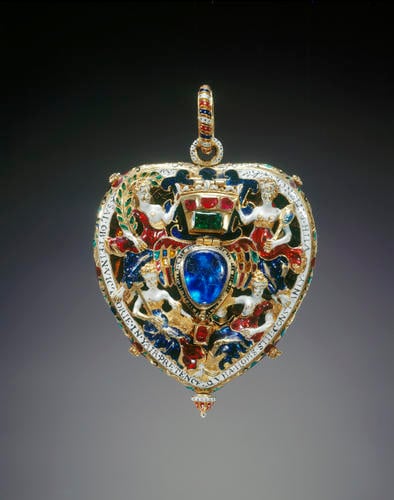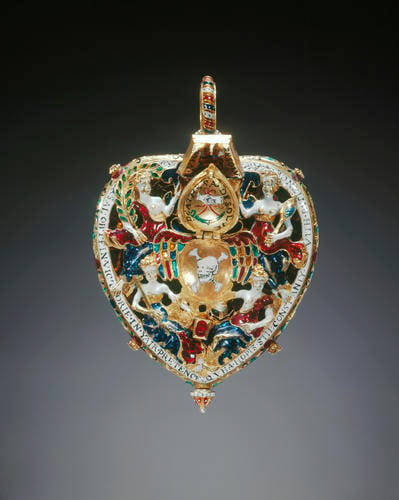-
1 of 253523 objects
The Darnley Jewel or Lennox Jewel c. 1571-8
Gold, enamel (émail en ronde bosse, émail basse-taille), Burmese rubies, Indian emerald and cobalt-blue glass | 6.6 x 5.2 cm (whole object) | RCIN 28181
-
Heart-shaped gold locket with polychrome enamels.
Obverse: figures of Faith, Hope, Victory and Truth surround a winged heart set with a blue glass cabochon. Surrounded by a white enamel border with the motto: QVHA. HOPIS. STIL.CONSTANLY. VITH PATIENCE SAL. OBTEAIN. VICTORIE. IN YAIR. PRETENCE (Who hopes still constantly with patience shall obtain victory in their claim). Above the heart Victory and Truth hold a crown set with three rubies and a table-cut emerald.
The crown is surmounted by a fleur-de-lis upon an azure shield. It opens to reveal two hearts pierced by two arrows and the motto in 16th century Scots: QUAT WE RESESOLV (What we resolve). Below the hearts is the monogram MSL (for Matthew and Margaret Stewart Lennox) surmounted by a wreath. The winged heart opens to reveal the device of two clasped hands and a green hunting horn surrounded by the inscription: DEATHE SAL DESOLVE (Death shall dissolve); below this device is a skull and crossbones.
Reverse: with numerous emblems in basse-taille enamel: the sun in his glory amid a star-studded azure sky; a crescent moon with a male profile; a crowned salamander among flames; a phoenix among flames; a pelican in her piety; the figure of a man reclining on grass with a large sunflower growing from his loins and a bird on a laurel branch behind him. Surrounded by the motto: MY STAIT TO YIR I MAY COMPAER FOR ZOV QVHA IS OF BONTES RAIR (My state to these I may compare for you who are of rare goodness).
The front of the locket opens to reveal further emblems: a stake among flames; a woman seated in a royal chair with the motto: GAR TEL. MY. RELaeS (Cause tell my release) on a scroll above her; a two-faced winged figure of Time with cloven feet holding an hour-glass in its left hand and extending its right hand to a naked female figure in a pool of water, with scrolls bearing mottos: TYM. GARES AL LEIR (Time causes all to learn) above and ZE SEIM. AL MY. PLESVR (You seem all my pleasure) below and the mouth of hell to the right. In the lower section are two further groups: an armed warrior and his fallen foe, who both wear classical armour, the fallen man points to a red shield by his side and a crowned warrior holding a female figure by the hair, his sword drawn as if to slay her.
The Lennox or Darnley locket is one of the most important early jewels in the Royal Collection. It is said to have been commissioned by Lady Margaret Douglas, Countess of Lennox (1515-78), for her husband Matthew Stewart, Earl of Lennox and Regent of Scotland, who fell in battle in 1571. Theories vary for which occasion the jewel was made. Generally it is believed to have been a memorial piece following the Earl’s death and certainly before Margaret’s own death although the jewel makes no allusion to the Earl’s death. It has also been suggested that it was made to commemorate the return of the exiled Earl to Scotland in 1564 or the restoration of his lands and honours in 1565.
The heart-shaped locket, or ‘tablet’ in the language of the 16th century, was intended to be worn around the neck or on the breast. The complex iconography of memento mori motifs and symbols of profane and sacred love relate to the Earl and Countess’s life together - the salamander is the crest of the house of Douglas and the heart its device and three fleurs-de-lis on an azure field form the first quarter of the Lennox arms. The jewel also reveals their ambitions for their grandson, the future James VI and I and provides him with the series of admonitions.
Although it is not known where the jewel was made, such high-quality workmanship was available in Edinburgh at that time. Three Edinburgh goldsmiths are suggested as possible candidates - George Heriot, Michael Gilbert II and James Gray.
The jewel was formerly in the collection of Horace Walpole (1717-97). It was purchased by Queen Victoria in 1843 from the London dealer Farrar of Wardour Street who had purchased it at the sale of Strawberry Hill the previous year for £136.10s. The Queen evidently took great interest in the purchase. In march 1843 John Glover, librarian at Windsor Castle, wrote to Henry Ellis - librarian at the British Museum - noting 'There has been forwarded for the Queen's inspection an enamelled ornament which is said to have belonged Darnley's mother. Her M. seems much interested about it and the Prince [Albert] gave it this morning to Mr Murray to get the old Scotch Legends deciphered.'
It was listed among the Queen's private jewellery taken ‘to the Castle’ following her death in 1901.
Text adapted from Ancient and Modern Gems and Jewels in the Collection of Her Majesty The Queen, London, 2008Provenance
Probably made for Lady Margaret Douglas, Countess of Lennox; Horace Walpole (d. 1797); by descent; sale of the contents of Strawberry Hill, George Robins, 11 May 1842 (lot 60); purchased by London dealer Farrar of Wardour Street (£136.10s); from whom purchased by Queen Victoria in 1843 (130 guineas)
-
Acquirer(s)
-
Medium and techniques
Gold, enamel (émail en ronde bosse, émail basse-taille), Burmese rubies, Indian emerald and cobalt-blue glass
Measurements
6.6 x 5.2 cm (whole object)
Category
Object type(s)
Other number(s)
Alternative title(s)
The Lennox Jewel





